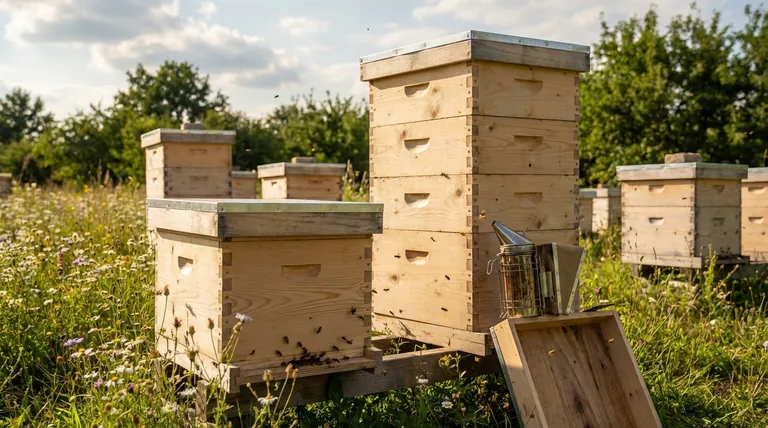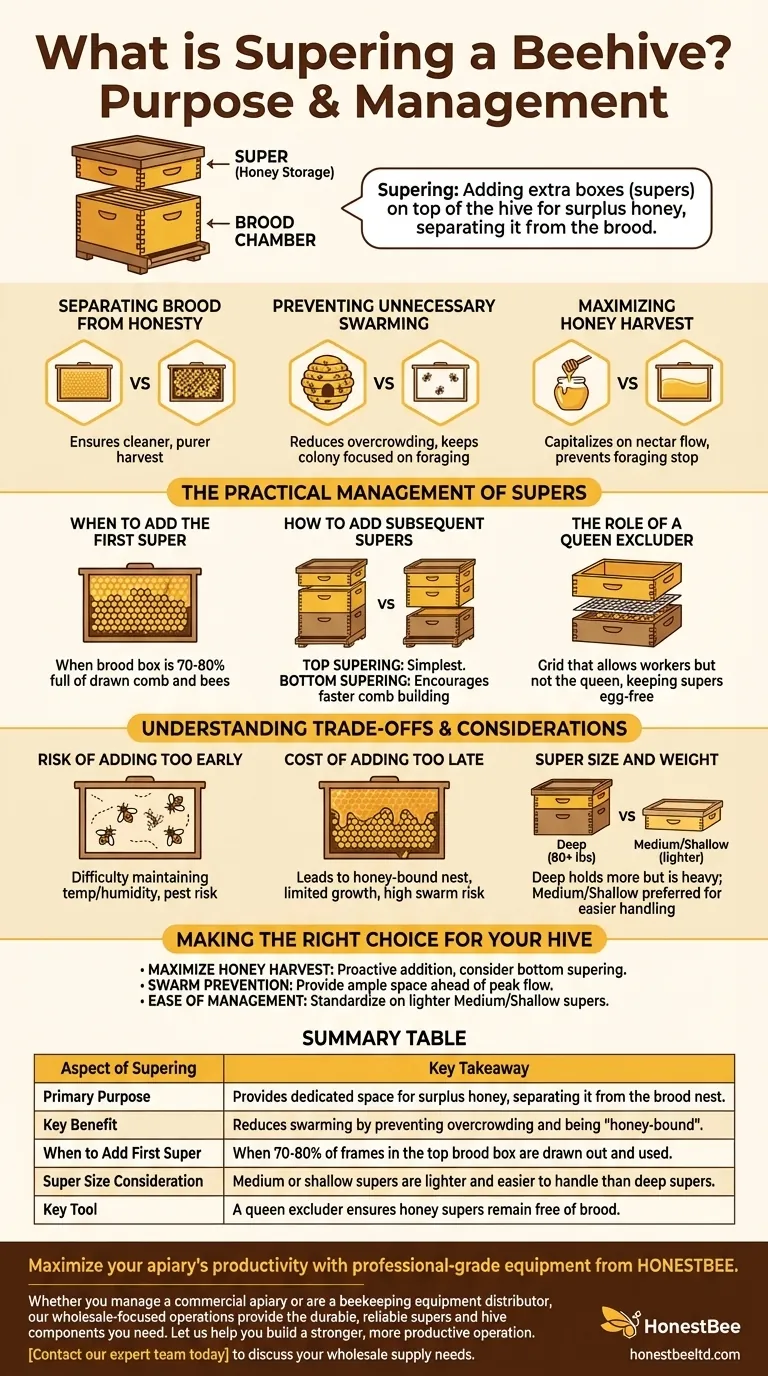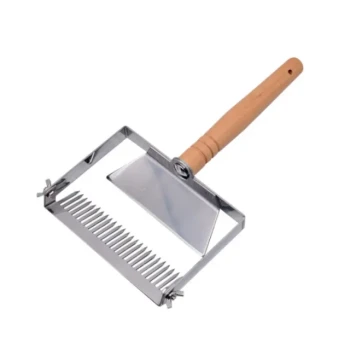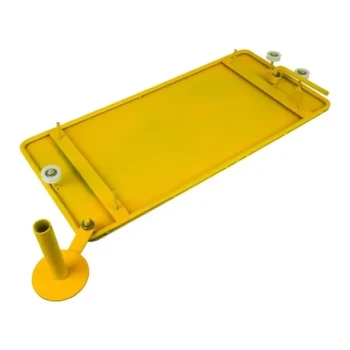Supering a beehive is the practice of adding extra boxes, known as supers, on top of the main hive. This is done to provide the colony with dedicated space to store surplus honey, especially during periods of high nectar availability. By creating a separate area for honey storage above the brood chamber, beekeepers can harvest this surplus efficiently without disturbing the queen and the developing bees below.
The fundamental goal of supering is not just to add space, but to strategically manage the hive's resources. It separates the colony's essential living quarters from the surplus honey production area, enabling a sustainable harvest while promoting colony health.

Understanding the "Why" Behind Supering
The addition of supers is a critical management technique that aligns with the natural behavior of honeybees. It addresses several key aspects of colony health and productivity.
Separating Brood from Honey
Bees naturally store honey above and around their brood nest. Supering formalizes this instinct by providing dedicated boxes for this purpose. This separation is crucial for the beekeeper, as it ensures honey frames are free of eggs and larvae, resulting in a cleaner and purer harvest.
Preventing Unnecessary Swarming
A primary trigger for a colony to swarm—the natural process of division where the old queen leaves with half the bees—is overcrowding. When bees run out of space to store nectar and the queen runs out of room to lay eggs, they initiate swarm preparations. Adding supers provides this essential space, reducing the swarming impulse and keeping the workforce focused on foraging.
Maximizing Honey Harvest
During a strong nectar flow, a healthy colony can fill a box with honey with surprising speed. Without adequate storage space, bees will stop foraging effectively. Supering ensures the colony never runs out of room, allowing them to capitalize on periods of natural abundance and produce a much larger surplus for the beekeeper.
The Practical Management of Supers
Knowing when and how to add supers is a skill that directly impacts the success of your hive. It involves observing the colony and anticipating its needs.
When to Add the First Super
Timing is everything. Add a super too early, and the bees will have too much space to patrol and keep warm. The most common signal to add the first super is when the bees have drawn out comb and are using 70-80% of the frames in the top brood box. This indicates they are nearing capacity and will need more room shortly.
How to Add Subsequent Supers
Once the first honey super is about 70% full, it's time to add another. There are two primary methods for this:
- Top Supering: The simplest method, where the new empty super is placed on the very top of the stack.
- Bottom Supering: The new empty super is placed directly above the brood box but underneath the already partially filled supers. This encourages bees to work through the new box to access their existing stores, often promoting faster comb building.
The Role of a Queen Excluder
Many beekeepers place a queen excluder between the top brood box and the first honey super. This is a flat grid with openings large enough for worker bees to pass through but too small for the larger queen. This is an effective tool to guarantee that no eggs are laid in the honey supers.
Understanding the Trade-offs and Considerations
While essential, supering involves judgments that can have significant consequences if made incorrectly.
The Risk of Adding a Super Too Early
Giving a colony too much space before they are ready can be detrimental. The bees may struggle to maintain the required temperature and humidity of the brood nest, and a smaller population will find it difficult to defend a large, empty space from pests like wax moths or small hive beetles.
The Cost of Adding a Super Too Late
Waiting too long to super is a common mistake. It can lead to the brood nest becoming "honey-bound," where cells needed by the queen for egg-laying are filled with nectar instead. This limits colony growth and is a powerful trigger for the colony to swarm, resulting in the loss of up to half your workforce and a significantly reduced honey harvest.
Super Size and Weight
Supers come in different depths: deep, medium, and shallow. While a deep super holds the most honey, it can weigh over 80 pounds when full. Many beekeepers prefer using medium or shallow supers for honey collection, as they are far lighter and easier to lift and manage.
Making the Right Choice for Your Hive
Your approach to supering should align with your primary beekeeping goals.
- If your primary focus is maximizing honey harvest: Be proactive. Add your first super when the top brood box is 70-80% full and consider bottom supering to encourage rapid comb building during a strong nectar flow.
- If your primary focus is swarm prevention: Do not wait until the hive is packed with bees. Providing ample space by supering ahead of the peak nectar flow is your most effective tool to keep the colony content.
- If your primary focus is ease of physical management: Standardize on using medium or shallow supers for all honey collection, as they are significantly lighter and easier to handle when full.
Ultimately, successful supering is about anticipating your colony's seasonal needs and providing the right amount of space at precisely the right time.
Summary Table:
| Aspect of Supering | Key Takeaway |
|---|---|
| Primary Purpose | Provides dedicated space for surplus honey, separating it from the brood nest. |
| Key Benefit | Reduces swarming by preventing overcrowding and being "honey-bound." |
| When to Add First Super | When 70-80% of frames in the top brood box are drawn out and used. |
| Super Size Consideration | Medium or shallow supers are lighter and easier to handle than deep supers. |
| Key Tool | A queen excluder ensures honey supers remain free of brood. |
Maximize your apiary's productivity with professional-grade equipment from HONESTBEE.
Whether you manage a commercial apiary or are a beekeeping equipment distributor, our wholesale-focused operations provide the durable, reliable supers and hive components you need to implement these supering strategies effectively. Let us help you build a stronger, more productive operation.
Contact our expert team today to discuss your wholesale supply needs.
Visual Guide

Related Products
- Wholesales Dadant Size Wooden Bee Hives for Beekeeping
- Plastic Handle Single Row Artificial Fiber Bee Brush
- Automatic Honey Flow Beehive 4 Frame Mini Hive for Beekeeping
- Economy Small Scale Honey Dryer Dehumidifier Thickening Machine
- Mesh Ventilated 3 Layer Goatskin Beekeepers Gloves for Beekeeping
People Also Ask
- What are the characteristics of oil-based paint for beehives? Durability vs. Modern Practicality
- What should beginners consider when purchasing beekeeping equipment? A Guide to Essential Starter Gear
- Why were wooden hives traditionally preferred? For Natural Beekeeping Aligned with Bee Biology
- What are the advantages of wooden bee hives? Superior Bee Health & Beekeeper Flexibility
- What is the best place to keep bees? Find the Perfect Apiary Site for Your Hives



















